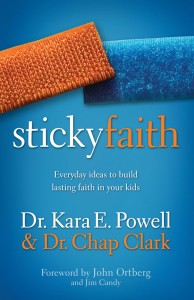This is part 5 in an 8 part series on Sticky Faith. Join our book club by signing up here. (part 1, 2, 3, 4)
 Let’s be careful about Chapter 5. It’s easy to read this and think about our ministry by default. To not apply what we are learning to our home would be a shame.
Let’s be careful about Chapter 5. It’s easy to read this and think about our ministry by default. To not apply what we are learning to our home would be a shame.
A couple quotes from this chapter jumped out at me:
- “The closest our research has come to that definitive silver bullet is this sticky finding: for high school and college students, there is a relationship between attendance at churchwide worship services and Sticky Faith.”
- “the high school students we surveyed who served in children’s or middle school ministry seemed to have stickier faith in both high school and college.”
- “Contact from at least one adult from the congregation outside the youth ministry during the first semester of college is linked with Sticky Faith.”
- “One family we know has a special ritual that involves sending their two sons to work with men they respect.”
Kristen: I think that I give up too easily by assuming that my children don’t want to sit at the grown-ups table. I grew up sitting in church with my family. At the time there wasn’t a simultaneous children’s church or youth service option. I’m sure there were times where I was disengaged although I can’t recall specific occasions. What I do remember even several years later is being together as a family, observing my parents in worship, and talking about the sermon on the drive home. Nowadays I almost feel apologetic if one of our children sits with us in the main service. While I’m thankful for fun, “age-appropriate” learning opportunities for my children, this chapter has me re-considering ideas to integrate them better at church.
Adam: When I think of my first interactions with the Tuckers (Kristen’s parents) I can’t help but laugh. I’d never been around a family like them. They hung out together all the time. They intentionally did stuff as a family… cheesy stuff like go to the library or park or zoo together. They all listened to Christian praise music on Sunday mornings to get their hearts ready for worship. And after church, I kid you not, they talked about the sermon. I sarcastically referred to them as The Swiss Family Robinson.
Of course, there was nothing wrong with the Tuckers. I just had no idea that there were actually families like that in real life who talked to one another and genuinely liked being together. In truth, they were just ahead of their time… developing Sticky Faith in their girls way before Kara & Chap wrote the book.
Kristen: I love the concept of purposely surrounding each of my children with five adults who care about them. I feel like this is especially important since we don’t live near extended family who would otherwise help fill that role. Reading through this portion of the chapter also prompts me to want to be “that” adult for my friend’s children. This chapter has so many great ideas. I particularly love the idea of forming an intergenerational group of families to invest in one others families.
Adam: I need to confess that this is an area we need to improve in. This chapter came with some good/convicting ideas we need to try. As I reflect on God’s Word in regards to parenting it is so clear that God intended plurality in parenting. As Kristen said, while that naturally involved extended family, we don’t live close to grandparents, aunts, uncles or cousins. So that means we need to be more intentional about building that web of relationships for our kids.
Discussion questions
- To what degree are your kids at the “kids’ table” in your life? What is good about that? What might be problematic?
- What are the advantages of trying to surround each of your kids with five adults who care about them? What are the challenges as someone in ministry?
- In your role in your church, how (if at all) can you help change your church’s culture? While you may have a limited sphere of influence at your church, what changes can you suggest in your own sphere?
- What ideas do you have to help your kids connect with other adults and move toward the 5:1 ratio?
5. How would you explain your 5:1 goal to your kids?

Leave a Reply